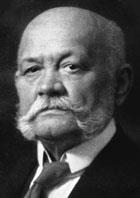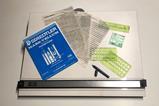One sure-fire way of entering the chemical pantheon is to get your name associated with a piece of kit

One sure-fire way of entering the chemical pantheon is to get your name associated with a piece of kit. Devise some apparatus used by every student in the world and glory is yours. Just imagine being Erlenmeyer and transforming the world of volumetric analysis by devising a sloping sided-flask which makes aliquots unsloppable. Sheer and utter genius. Or Buchner’s funnel, which every chemist alive has used at one point or another to isolate a precious product. A funnel with your name on it – now that’s fame. There’s only one question: who was Buchner, anyway? Does anyone really remember the chemists who invented these classics?
Over the next year, Classic Kit takes a closer look at the workhorse laboratory apparatus chemists use every day – and the forgotten lives of the scientists who named them.
In chemistry most apparatus is rather dull to watch. There’s not much to see. A condenser. well, it just condenses. A pipette delivers its aliquots. But one piece of glassware stands out for its ability to draw a crowd: the Soxhlet extractor.
Consisting of a glass reservoir which sits between a lower flask at the bottom and a condenser at the top, the Soxhlet allows one to extract chemicals from a solid sample into a liquid, leaving behind insoluble impurities. Cleverly, it uses a small volume of solvent over and over again.

The basic set-up is shown on the right. Inside the reservoir sits a thimble-shaped filter in which one’s sample is placed at the start of the procedure. The solvent is heated up from its starting position in the lower flask. As the solvent (shaded green) boils, the condenser (with cool water flow, shaded blue) returns it to drip steadily into the thimble. This allows the soluble components of the sample (shaded red) to be extracted.
The clever part of the design is the presence of a siphon tube on the side of the extractor. As the solvent fills the reservoir, it also rises up in the siphon until this overflows. Suddenly, as if by magic, the reservoir flushes, much like a toilet, drawing the solvent and the precious extract down to the bottom, an event often accompanied by merry cheers from the, admittedly rather nerdy, onlookers. The cycle then starts again once the solvent comes back to the boil. The extraction reservoir is kept warm by placing it directly above the heated solvent flask, enhancing the effectiveness of the device.
The Soxhlet extractor is named after Franz Ritter von Soxhlet, a German chemist of Belgian extraction born on 12 January 1848 in Brünn (now Brno in the Czech Republic). He studied chemistry in Leipzig where he got his PhD and then became an assistant at the Institute of Agricultural and Animal Chemistry. He moved to Vienna the following year and stayed there until 1879 when he became professor of Animal Physiology and Dairy at the Agricultural 'High School' in Munich. He stayed in Munich until his death on 5 May 1926, at the age of 78.
Much of his research career was spent investigating the properties of milk. He was the first to describe lactose and to separate the major milk proteins: casein, albumin, lactoprotein and globulin. In 1886 Soxhlet was the first to suggest that the recently invented process of pasteurisation be applied to milk, and five years later he developed a simple sterilisation (pasteurisation) device which could be used on babies’ bottles.
It was in Vienna that he invented his device to extract the lipophilic components (fats) from milk solids. In 1879 he published a paper, Die gewichtsanalytische Bestimmung des Milchfettes, in Dingler’s Polytechnisches Journal, in which he described his new extractor.
It caught on rapidly and became widely used across chemistry, biochemistry, the food, plastics and oil industries – anywhere which required exhaustive extractions, and Soxhlets were often set up in batteries flushing away endlessly.
But the joke is that in many labs, where the Soxhlet is only used occasionally, this amazingly simple labour-saving device is the very one which stops labwork dead as everyone gathers round to watch the action.

















No comments yet